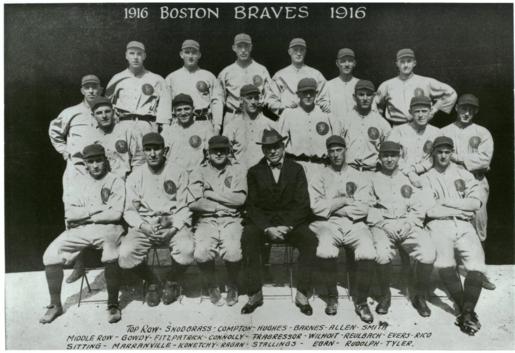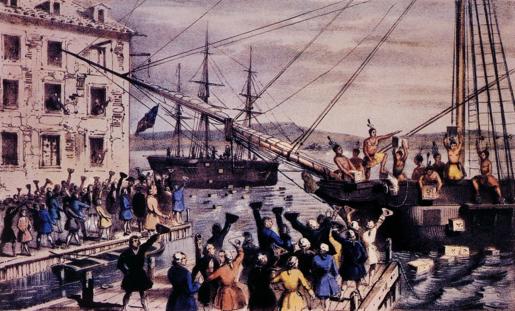Were the Boston Braves Named After Members of the Boston Tea Party?
Here is the latest in a series of examinations into urban legends about baseball and whether they are true or false. Click here to view an archive of the baseball urban legends featured so far.
BASEBALL URBAN LEGEND: The Boston Braves were named after the members of the Boston Tea Party.
An interesting part of baseball history that is worth noting is how few of the current baseball team nicknames were used prior to the 20th Century. Don’t get me wrong, some teams certainly do have nicknames going as far back as the 19th Century, but most teams had informal nicknames that would often change seemingly at a whim.
The first Boston baseball club is a good example of this, as they entered the National Association in 1871 known informally as the Boston Red Stockings (in honor of the first professional baseball team, the Cincinnati Red Stockings, who had dissolved following the 1870 season).

In 1876, they joined the newly formed National League and since a new version of the Cincinnati Red Stockings were also in the league, the Boston team became known as the Red Caps (a lot of teams went by the colors of their uniforms). That name stuck for a few years before they began being referred to as the Boston Beaneaters from 1883 until 1906. During this time, the American League had debuted and they had a rival Boston baseball team, known as the Boston Americans. When the Beaneaters dropped red from their uniforms after the 1906 season, the rival Boston team quickly picked it up themselves and became known as the Red Sox.
The newly red-less team now had all-white uniforms, and since their owner’s last name was Dovey, the press quickly dubbed them the Boston Doves in 1907. That name stuck for a few years before they tried the Boston Rustlers in 1911 and then, finally, the name that they would use for almost all of the next century (and still use today), the Boston Braves.

But the origin of the Braves name is a confusing one, especially as the name carries with it controversy (along the lines of other teams named after Native Americans, like the Washington Redskins and the Cleveland Indians). Defenders of the Braves often point out that the name is actually derived from a significant event in United States history – the famed Boston Tea Party.
Is that true?
Not only is that not true, but the truth is that the team name actually came from a New York organization!
The Boston Tea Party, of course, was a political protest that occurred in Boston in December of 1773. For the previous decade or so, there was a large debate over the importation of tea from Europe. The British Government used taxes on tea to help pay the salaries of Colonial government officials, as they wished to be able to keep control of these officials themselves, rather than allow them to fall under the sway of the colonists. In addition, they wished to make it clear that the British Government had the right, if they so chose, to tax the American colonies. The Tea Act of 1773 actually REDUCED the price of British imported tea in the colonies. To that point, colonists would often import non-taxed Dutch tea, which was cheaper. After the Tea Act, the British tea was actually now cheaper than the smuggled Dutch tea (this was done because there was a massive surplus of tea at the time). The tea would be sold by specially selected merchants, who would sell the tea on consignment. This was partially done so that the tax would be (hopefully) hidden from the public, as the tax would only be paid when the consignees settled up their accounts with the East Indies Tea Company – but the news of the tax did not stay hidden long.
So it was not the monetary cost of the taxes in the Tea Act that caused anger in the colonies, it was the idea of the British government taxing the colonists without the colonists being given elected representation as well as the notion that the taxes would be used to keep colonial officials under British control (a secondary concern was the colonial merchants who made their living off of smuggled Dutch tea, who would now be put out of business by the cheaper, legal tea).
Protests began all over the colonies, and the imported tea was actually sent back in three cities (Charleston, Philadelphia and New York) where protesters compelled the consignees to quit. With no one to accept the tea, the tea was returned.
Massachusetts Royal Governor Thomas Hutchinson, however, refused to back down. Two of the consignees in Boston were his own sons, so he insisted that they accept the tea. So protesters, often calling themselves the Sons of Liberty, conspired to find some way to stop the importation. After a series of meetings, they assigned groups of twenty-five men to guard the boat to make sure the tea was not unloaded. The rules of the time stated that cargo must be unloaded within twenty days. The protesters’ plan was to force the twenty days to pass, forcing custom officials to impound the tea (that’s what happened in Philadelphia).
Hutchinson, however, refused to allow the ship to leave and two more ships arrived in Boston Harbor. On the eve of the deadline, where the issue would really have been forced, Samuel Adams led a meeting to discuss their options. It is disputed whether Adams was involved in the actual planning of what came next, but whether he was or not, a group of men (reports have varied widely over the years as to how many men, some say as few as 30, some say as many as 130), many of whom wore “disguises” as members of the Mohawk tribe, boarded the tea ships and destroyed all of the cargo.

This act was a major event in the road to the eventual Declaration of Independence by the colonies.
So defenders of the “Brave” nickname suggest that the nickname came about because of those Sons of Liberty who were dressed as Mohawks. They would, in effect, be “Boston Braves” (even then, though, the Tea Party members were dressed as Mohwaks, so it was still connected to Native Americans).
That, however, is not the case.
In actuality, the name came from new owner, James Gaffney, who purchased the team in 1912. Gaffney was a member of the Tammany Society, the mostly Irish wing of the Democratic Party political machine in New York City. The Society was named after a Native American leader of the Lenape tripe, a fellow named Tamanend. The Tammany Society had a picture of an Native American brave as their logo and had a white marble statue of Tamanend on the façade of the building that was their headquarters, Tammany Hall. Boston team president John Montgomery Ward suggested the idea of naming the team after the Tammany logo and everyone agreed.
Gaffney sold the team three years later, but the name stuck. The only time the Braves changed their name was a brief period in the mid 1930s when they had a fan poll that led to them being called the Boston Bees from 1936-1941. From 1941 on, though, they have been the Braves, even after they moved to Milwaukee in 1953 and Atlanta in 1966.
The legend is…
STATUS: False
Feel free (heck, I implore you!) to write in with your suggestions for future installments! My e-mail address is bcronin@legendsrevealed.com.
Tags: Atlanta Braves, Boston Americans, Boston Beaneaters, Boston Bees, Boston Braves, Boston Doves, Boston Red Caps, Boston Red Sox, Boston Red Stockings, Boston Tea Party, James Gaffney, John Montgomery Ward, Milwaukee Braves, Tammany Society, Tammend





